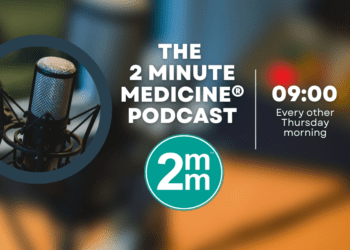Plateau observed in the declining rate of pediatric outpatient antibiotic use
Image: PD
1. Although pediatric antibiotic dispensing decreased during early during the study period of 2000-2010, this downward trend slowed or plateaued by the end of the decade.
2. Across the study period, the use of first generation penicillins and second-generation cephalosporins decreased in all age groups, however increased use of broad-spectrum third-generation cephalosporins was observed.
Evidence Rating Level: 2 (Good)
Study Rundown: Over the past two decades, there have been coordinated efforts to decrease pediatric antibiotic dispension due to fears of the development of antibiotic resistant bacteria. This study evaluated pediatric antibiotic prescription patterns from 2000 to 2010 among children (aged 3 months to < 18 years) in the New England, Mountain West and Midwest regions. Antibiotic dispension was highest for children aged 24 months to 3 years. Overall antibiotic prescription rates across all geographic areas for all ages was significantly lower in the study period from 2009-2010 as compared to the period of 2000-2001 (p<0.001). The rate of decline of antibiotic dispension was noted, however, to slow or stabilize in the latter half of the study decade, with the exception of antibiotic prescription for children adolescents aged 6-18 in the Midwest region. In addition, although prescriptions of first generation penicillins and second generation cephalosporins decreased over the past decade, there was an increase in prescription of third generation cephalosporins. Antibiotic prescription patterns in the Mountain West region of study were noted to be consistently lower across the study period and across all age groups than in New England and the Midwest (p<0.001).
The investigators concluded that antibiotic dispension in the pediatric outpatient setting may have reached a plateau. In addition, in older age groups prescription rates may be increasing. They point to regional variation in antibiotic prescription patterns and suggest that best practices for antibiotic use should be developed to further reduce antibiotic use among the pediatric outpatient population, focusing particularly on broad-spectrum agents.
Click to read the study in Pediatrics
Relevant Reading: Reducing Antibiotic Use in Children: A Randomized Trial in 12 Practices
In-Depth [retrospective cohort]: This study evaluated pediatric outpatient antibiotic prescription rates across three, geographically distinct commercial health plans from 2000 to 2010. Antibiotic dispension varied significantly across all three plans (p<0.001), with consistently less antibiotic prescription in the Mountain West. Rates of antibiotic prescription declined across all age groups within all three healthcare plans (p<0.001); however, rates of change differed between age groups. Among children aged 24 months to 3 years, prescription rates declined significantly until approximately 2004, when rates of decline stabilized at approximately 2% per year in the North East and Mountain West, while ceasing to decline in the Midwest. Similar trends were observed in antibiotic prescriptions for children aged 4 to 6 and 6 to 12 years. Among adolescents aged 12 to 18, rates of antibiotic prescription increased or stabilized across the three plans. When evaluated by type of antibiotic, it was noted that the dispension of penicillins, amoxicillin-clavulanate, and second generation cephalosporins decreased across all age groups while there were notable increases in third-generation cephalosphorin prescriptions. The leading diagnosis associated with third generation cephalosporin prescription from ages 24 months to 12 years was otitis media, while third generation cephalosporins were most commonly prescribed for sinusitis among adolescents.
More from this author: AAP urges bottle feeding over breastfeeding in mothers with HIV, Pediatric influenza burden remains high despite new vaccination recommendations, Cow’s milk consumption linked to increased vitamin D and decreased iron stores in early childhood
© 2012-2014 2minutemedicine.com. All rights reserved. No works may be reproduced without expressed written consent from 2minutemedicine.com. Disclaimer: We present factual information directly from peer reviewed medical journals. No post should be construed as medical advice and is not intended as such by the authors, editors, staff or by 2minutemedicine.com. PLEASE SEE A HEALTHCARE PROVIDER IN YOUR AREA IF YOU SEEK MEDICAL ADVICE OF ANY SORT.




![Oral amoxicillin as effective as injectable benzylpenicillin-gentamicin for infants with infection in which referral not possible [AFRINEST Trial]](https://www.2minutemedicine.com/wp-content/uploads/2015/04/NOVAMOXIN_antibiotic-350x250.jpg)


